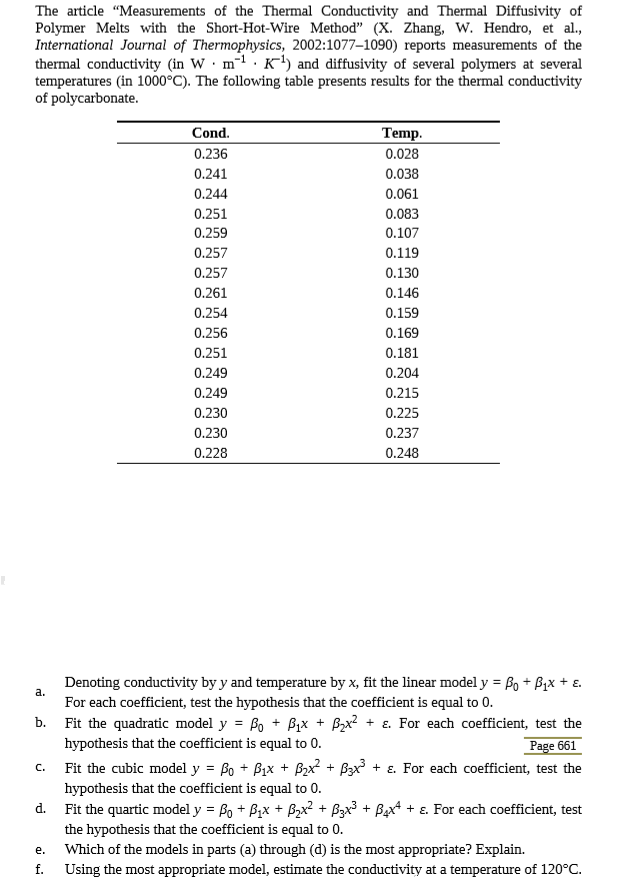
MATLAB: An Introduction with Applications
6th Edition
ISBN: 9781119256830
Author: Amos Gilat
Publisher: John Wiley & Sons Inc
expand_more
expand_more
format_list_bulleted
Question

Transcribed Image Text:The article "Measurements of the Thermal Conductivity and Thermal Diffusivity of
Polymer Melts with the Short-Hot-Wire Method" (X. Zhang, W. Hendro, et al.,
International Journal of Thermophysics, 2002:1077-1090) reports measurements of the
thermal conductivity (in W· m-1 . K') and diffusivity of several polymers at several
temperatures (in 1000°C). The following table presents results for the thermal conductivity
of polycarbonate.
Cond.
Temp.
0.236
0.028
0.241
0.038
0.244
0.061
0.251
0.083
0.259
0.107
0.257
0.119
0.257
0.130
0.261
0.146
0.254
0.159
0.256
0.169
0.251
0.181
0.249
0.204
0.249
0.215
0.230
0.225
0.230
0.237
0.228
0.248
Denoting conductivity by y and temperature by x, fit the linear model y = Bo + Bix + ɛ.
a.
For each coefficient, test the hypothesis that the coefficient is equal to 0.
b. Fit the quadratic model y = Bo + Bix + Bzx? + ɛ. For each coefficient, test the
Page 661
Fit the cubic model y = Bo + Bix + Bx + Bax + ɛ. For each coefficient, test the
%3D
hypothesis that the coefficient is equal to 0.
C.
hypothesis that the coefficient is equal to 0.
d. Fit the quartic model y = Bo + B1x + Bzx? + Bzx³ + Bx* + ɛ. For each coefficient, test
the hypothesis that the coefficient is equal to 0.
e.
Which of the models in parts (a) through (d) is the most appropriate? Explain.
f.
Using the most appropriate model, estimate the conductivity at a temperature of 120°C.
Expert Solution
This question has been solved!
Explore an expertly crafted, step-by-step solution for a thorough understanding of key concepts.
Step by stepSolved in 4 steps with 3 images

Knowledge Booster
Similar questions
- (11) Let X, Y be independent random variables with X ~ Exp(A1) and Y - Erp(A2). Find the joint density of Z = X +Y,W = X – Y. The following answers are provided. Read the answers carefully before making your choice. (a) The inverse transformation is I = v (z, w) = (z + w)/2, y = v2(z, w) = (z – w)/2. The jacobian of the transformation is the following determinant J = = The bivariate density of Z, W is g(z, w) = A1A2e 1(=+w)/2e¬A2(z¬w)/2 |J], if 쁘 > 0, > 0. This is equivalent to saying that if – z 0, " > 0. This is equivalent to saying that if – z 0, 를 >0. This is equivalent to saying that if - 00 0," > 0. This is equivalent to saying that if – z 0, > 0. This is equivalent to saying that if – z< w < z, 0 < z g(z, w) = if otherwise, (a) (b) (c) (d) (e) N/A (vii- Select One)arrow_forwardLet X1, .., Xn be a random sample from a population with 0 unknown and given by the density = * itz>0 { e f(x; 8) if x (Ə ln(f(X;0) nEarrow_forwardTwo components of a minicomputer have the following joint pdf for their useful lifetimes X and Y. (If an answer doesn't exist enter DNE.) Sxe-x(1 + y) x 2 0 and y 2 0 f(x, y) = otherwise Determine E(XY). E(XY) = Calculate Cov(X, Y) and p. Cov(X, Y) = P =arrow_forward
Recommended textbooks for you
 MATLAB: An Introduction with ApplicationsStatisticsISBN:9781119256830Author:Amos GilatPublisher:John Wiley & Sons Inc
MATLAB: An Introduction with ApplicationsStatisticsISBN:9781119256830Author:Amos GilatPublisher:John Wiley & Sons Inc Probability and Statistics for Engineering and th...StatisticsISBN:9781305251809Author:Jay L. DevorePublisher:Cengage Learning
Probability and Statistics for Engineering and th...StatisticsISBN:9781305251809Author:Jay L. DevorePublisher:Cengage Learning Statistics for The Behavioral Sciences (MindTap C...StatisticsISBN:9781305504912Author:Frederick J Gravetter, Larry B. WallnauPublisher:Cengage Learning
Statistics for The Behavioral Sciences (MindTap C...StatisticsISBN:9781305504912Author:Frederick J Gravetter, Larry B. WallnauPublisher:Cengage Learning Elementary Statistics: Picturing the World (7th E...StatisticsISBN:9780134683416Author:Ron Larson, Betsy FarberPublisher:PEARSON
Elementary Statistics: Picturing the World (7th E...StatisticsISBN:9780134683416Author:Ron Larson, Betsy FarberPublisher:PEARSON The Basic Practice of StatisticsStatisticsISBN:9781319042578Author:David S. Moore, William I. Notz, Michael A. FlignerPublisher:W. H. Freeman
The Basic Practice of StatisticsStatisticsISBN:9781319042578Author:David S. Moore, William I. Notz, Michael A. FlignerPublisher:W. H. Freeman Introduction to the Practice of StatisticsStatisticsISBN:9781319013387Author:David S. Moore, George P. McCabe, Bruce A. CraigPublisher:W. H. Freeman
Introduction to the Practice of StatisticsStatisticsISBN:9781319013387Author:David S. Moore, George P. McCabe, Bruce A. CraigPublisher:W. H. Freeman

MATLAB: An Introduction with Applications
Statistics
ISBN:9781119256830
Author:Amos Gilat
Publisher:John Wiley & Sons Inc

Probability and Statistics for Engineering and th...
Statistics
ISBN:9781305251809
Author:Jay L. Devore
Publisher:Cengage Learning

Statistics for The Behavioral Sciences (MindTap C...
Statistics
ISBN:9781305504912
Author:Frederick J Gravetter, Larry B. Wallnau
Publisher:Cengage Learning

Elementary Statistics: Picturing the World (7th E...
Statistics
ISBN:9780134683416
Author:Ron Larson, Betsy Farber
Publisher:PEARSON

The Basic Practice of Statistics
Statistics
ISBN:9781319042578
Author:David S. Moore, William I. Notz, Michael A. Fligner
Publisher:W. H. Freeman

Introduction to the Practice of Statistics
Statistics
ISBN:9781319013387
Author:David S. Moore, George P. McCabe, Bruce A. Craig
Publisher:W. H. Freeman